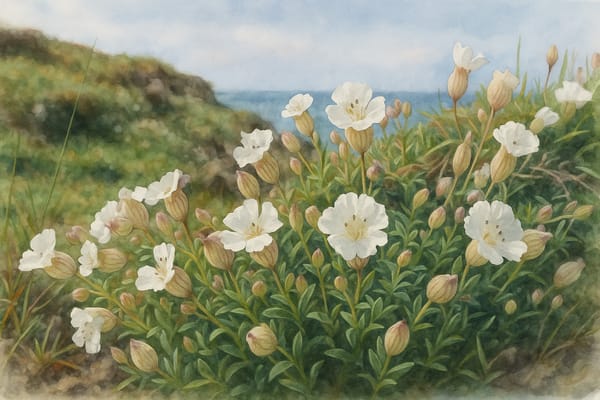Sea Campion (Silene uniflora)
Known as dead man’s bells in Cornish folklore, Sea Campion thrives where cliffs meet sea. Resilient, low-maintenance, and rich in coastal myth, it’s a symbol of survival and a perfect plant for wild, windy gardens.


Known as dead man’s bells in Cornish folklore, Sea Campion thrives where cliffs meet sea. Resilient, low-maintenance, and rich in coastal myth, it’s a symbol of survival and a perfect plant for wild, windy gardens.


Known across Cornwall’s wild cliffs and wind-blown shores, Sea Campion—with its pale, papery flowers and tight silver foliage—has long been a quiet sentinel of the coast.
Names & Folklore:
In Cornish and British coastal folklore, Sea Campion is known by eerie and evocative names: Dead Man’s Bells, Witches’ Thimbles, Devil’s Hatties. These nicknames reflect superstitions that surrounded the plant—particularly the belief that picking it would invite misfortune or even death. The fear likely arose from its perilous cliffside habitat, where gathering flowers could mean danger or fatal slips.
A Symbol of Endurance:
Despite its dark lore, Sea Campion was also believed to offer protection from evil spirits and symbolised resilience. Its tough roots and low, mat-forming growth allow it to thrive in the harshest places, making it a powerful metaphor for survival and strength in Cornish storytelling.
Children’s Folklore:
Children once played with Sea Campion’s inflated calyces, turning them inside out to mimic tiny dancers or washerwomen. These small rituals brought gentler meaning to the plant, blending fear and fascination with innocence and imagination.
Cultural Legacy:
Sea Campion is now recognised not only as a botanical mainstay of the Cornish coastline but as a cultural emblem. Its form, scent, and tenacity speak of a deep-rooted connection between land, sea, and memory.
Sea Campion is a resilient, low-maintenance choice for exposed sites, offering ground-hugging mats of silver foliage and bright white flowers that dance in the wind like foam on stone.
| Requirement | Details |
|---|---|
| Light | Full sun preferred; tolerates light shade |
| Soil | Well-drained, sandy or gritty; neutral to slightly alkaline |
| Moisture | Low; drought-tolerant once established |
| Salt Tolerance | Exceptional; thrives in salty air and wind |
| Hardiness | Fully hardy in the UK |
Sea Campion is one of the finest native plants for exposed maritime gardens. It holds soil on banks, softens hard edges in gravel or paving, and brings year-round texture. Its cushion-like growth supports pollinators, and its heritage connects gardeners with the folklore and ecology of Cornwall’s cliff paths and headlands.
Whether used to edge a path, stabilise a slope, or spill over a stone wall, Sea Campion provides structure, symbolism, and resilience—rooted deeply in place and story.
| Step | Traditional Tip |
|---|---|
| Site & Soil | Full sun, poor sandy or gritty soil |
| Sowing | Direct in spring or autumn; easy from seed |
| Watering | Low needs; drought-tolerant once established |
| Maintenance | No feed; deadhead to neaten; divide clumps to spread |
| Coastal Fit | Wind- and salt-tolerant; ideal for cliffs, dry banks, and walls |